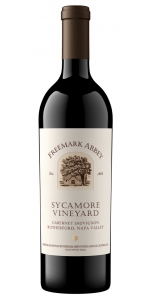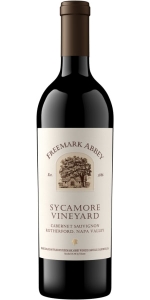Wine from Freemark Abbey

For over half a century, America’s premier grape-growing state has enjoyed a reputation more or less interchangeable with Cabernet Sauvignon’s. It’s the king of red wine grapes in California—and also in France—for a reason: the amazing complexity that skilled winemakers are able to coax out of it when grown in optimum locations. They know all about this in the great, old chateaux of Bordeaux, as well as at many younger, but equally prestigious, wineries in Napa Valley. The world’s best Cabernet grapes are grown in these respective regions.
On the short list of the latter sits Freemark Abbey, a St. Helena winery founded in 1886, that hasn’t been “young” for a long time. With nearly 50 vintages’ worth of Napa Valley Cabernet Sauvignon vintages tucked away in its library, Freemark’s signature portfolio of wines represents one of the most fully realized Cabernet programs in America. They're produced by a winery whose contemporary rise to prominence has, from the 1960s to present, coincided with that of California’s fine wine industry.
Today, Freemark Abbey is many things to many people: a team of some of the most respected winemakers working in Napa Valley; a historic 1886 winery and pristine estate, with an enthusiastic hospitality program that highlights both; a collection of source vineyards up and down Napa Valley, representing several of California’s most distinctive terroirs; an extensive—and unparalleled—wine library that stretches back decades; and a winery that, because of its long history and international reputation, is one of Napa Valley’s true ambassador brands.
Freemark Abbey’s newly appointed Winemaker Emeritus, Ted Edwards, has overseen much of its ascendance. As he moves into a self-described “co-pilot” role to new Winemaker Kristy Melton, he can reflect on the changes he’s witnessed at this iconic St. Helena winery over 40 years.
Moving forward, Ted’s job will be to offer advice and counsel to Kristy and her winemaking team, to continue in a leading viticultural role, and to carry on as Freemark’s most experienced proponent. The two Rutherford vineyards, Bosché and Sycamore, are, like Ted himself, closely linked to the winery’s identity. This won’t change. What will change is Ted’s ability to focus his energy on the growing protocols at this pair of vineyards, which are closer to his winemaker’s heart than any others in Napa Valley.
The transition from Ted to Kristy in 2020 is just another step in the evolution of this extraordinary wine estate. There are bookends to the story, however, at least up to the present day: a pioneering, unstoppable woman founded the property 135 year ago, and today an equally unique and determined woman is taking charge.
Freemark Abbey Bosche Cabernet Sauvignon is made from 93% Cabernet Sauvignon, 7% Merlot.
The nose exhibits aromas of black cherry, mocha, cassis and forest floor. The palate is bright yet creamy and filled with notes of forest fruits, leather, baking spices and soft vanilla. The textures are vibrant and integrated making this wine lovely now with the ability to age for decades in the cellar.
Review:
Blended with 7% Merlot from the famous site, along the benchlands of the Mayacamas, this is a juicy, delicious and sophisticated wine, with impressive, complementary bolts of freshness and intensity that are fully in sync. Notes of gravel, black cherry, currant and herb ride along a structured and generous palate of memorable greatness. Enjoy best from 2028–2038. Cellar Selection
- Wine Enthusiast 98 Points
Freemark Abbey Sycamore Cabernet Sauvignon is made from
Wine Profile: Opaque dark ruby describes the color of this Rutherford wine. Black currant and Boysenberry notes dominate the aroma, with dark chocolate truffle, cocoa powder, Worcestershire sauce, cremini mushrooms and forest floor adding to the complexity. The oak adds the ideal amount of complexity with aromatic cedar, cinnamon and clove. The wine has great depth of black fruit flavor, with a strong expression of sweet black cherry. This full-bodied cabernet sauvignon has resolved tannins yet firm structure, with good acidity. Lovely long finish!
Primary Vineyard: Sycamore Vineyard—Rutherford (100%): Small 24-acre vineyard located about 1.2 miles south of Bosche, right up against the Mayacamas Range, this vineyard has a rich clay loam. Sycamore Vineyard produces small berries reminiscent of mountain fruit berries, with intense extract of color and flavor. The color is very dark early in the fermentation, with flavors of black currant and black berry with a forest floor complexity.
Review:
From a vineyard closer to the Mayacamas Mountains and first made in 1980, the 2016 Cabernet Sauvignon Sycamore Vineyards checks in as 88% Cabernet Sauvignon, 7% Merlot, and the rest Petit Verdot and Cabernet Franc. It spent 27 months in 66% new French. It offers more black fruits, earth, tobacco, cedar, and gravelly minerality as well as a touch more burly, masculine style on the palate. Nevertheless, it's still beautifully balanced, has considerable elegance, and a great finish.
-Jeb Dunnuck 95 Points
Deep garnet-purple colored, the 2016 Cabernet Sauvignon Sycamore Vineyards gives up powerful crème de cassis, dark chocolate-covered cherries, mulberries and baked plums scents with hints of lavender, camphor, pencil shavings and dusty soil. Medium to full-bodied, the palate is packed with rich, black fruits plus a beautiful perfumed undercurrent, framed by finely grained tannins and lovely freshness, finishing with a mineral lift. 1,989 cases were made.
-Wine Advocate 95 Points
Herbal, with characteristics of peppercorn, cedar and pencil shavings, this beautiful wine is also dusty and mineral-driven, with demure flavors of red and black currant. Full bodied and well structured, it shows an underlying softness that should continue to soften in the cellar. Enjoy best from 2026–2031.
-Wine Enthusiast 95 Points
The nose opens with aromas of blackberry, blueberry, black current and boysenberry. The fruit elements are complimented with notes of forest floor, cigar box, dark chocolate and espresso. The wine is rich and balanced and French oak barrels add the ideal amount of complexity with notes of baking spice and warm vanilla. This is a full-bodied wine with integrated tannins that give it a long, lingering finish. Stunning.
Primary Vineyard: Sycamore Vineyard—Rutherford (100%): Small 24-acre vineyard located about 1.2 miles south of Bosche, right up against the Mayacamas Range, this vineyard has a rich clay loam. Sycamore Vineyard produces small berries reminiscent of mountain fruit berries, with intense extract of color and flavor. The color is very dark early in the fermentation, with flavors of black currant and black berry with a forest floor complexity.
Review:
Mint, spearmint, dark-berry and blueberry aromas. Leaves and sage, too. Full-bodied and firm with fantastic depth. Cool fruit with menthol and mint. Spice. Refreshing. Firm tannins. Fantastic 2017. Drink or hold.
-James Suckling 97 Points
- back
Selected Options
Wineries
Categories
Pricing
Countries
Regions
Grape Types
Wineries
Organic/Free Shipping
Paul Hobbs Coombsville Cabernet Sauvignon is made from 100% Cabernet Sauvignon
Since our inaugural release last year, this wine has quickly become one of the most compelling in their portfolio. Offering a gorgeous deep purple hue, our 2019 captivates with a bouquet of crushed blueberry, summer savory spice, and a delicate tobacco leaf note. The palate is remarkably balanced with well-integrated
tannins and fresh acidity that wraps around boysenberry and black fig along subtle notes of rosemary and a crush rock minerality, which lends tension through the long finish.
Review:
With an attention- getting purple-black hue, this astound- ing red is silky but manages to eke out teeth-grabbing, dusty black-tea tannins. A host of flavors, among them graphite, black raspberry, violets, and Worces- tershire, sends a message of intensity. Earth and soil notes are apparent, sur- rounding a mineral component within the wine's deep core.
-Tasting Panel 98 Points
Argot Bastard Tongue Pinot Noir is made from 100 percent Sonoma Pinot Noir.
Inheriting an unbroken string of success, the “Bastard Tongue” arrives fully-formed and ready to impress. Always a blend from multiple Pinot Noir vineyards, this iteration of “BT” was selected from three distinct sites, each making their own unique contribution of Sonoma County terroir to the wine’s character.
Exploding forth on a tidal wave of high-toned, intense red and black fruits, this is a Pinot Noir that no stemware can contain. The palate’s profound depth is balanced by an inherent freshness, allowing the wine to crackle with brambly energy, while sustained by bass notes of underbrush, black tea, pie spice and baker’s chocolate. A formidable rendition of “Bastard Tongue”, and a deserving successor to its line.
Night harvested by hand throughout September, cluster and berry sorted by hand, de-stemmed, no crushing. 7-day cold soaks, followed by native fermentation in open-top bins. Average time on the skins, 14 days. Aging 20 months in French oak, 100% new. Never racked prior to bottling. Bottled unfined, unfiltered.
Very versatile for pairing. Goes well with grilled meat, vegetable, fish, poultry and cheese.
Review:
"The 2022 'Bastard Tongue' Pinot Noir from Argot is utterly mind-blowing. It immediately draws you in with its seductive aromatic of fresh black raspberries, wild strawberries and even a touch of blueberry all woven together with sweet spices, cinnamon, crushed violets and earthy undertones. On the palate, the wine is both rich and graceful, with a lively acidity that elevates the sweet red fruit notes of red currant and black raspberries. Fine, polished tannins provide a round, silky texture that leads into a supple finish that lingers with sweet berries and sweet spices. This Pinot Noir offers a beautiful balance of elegance and complexity, drinking beautifully now, with a depth that promises further enjoyment. This is one of the most delicious bottles of Pinot Noir I can recall." - 98 Points, International Wine Report







